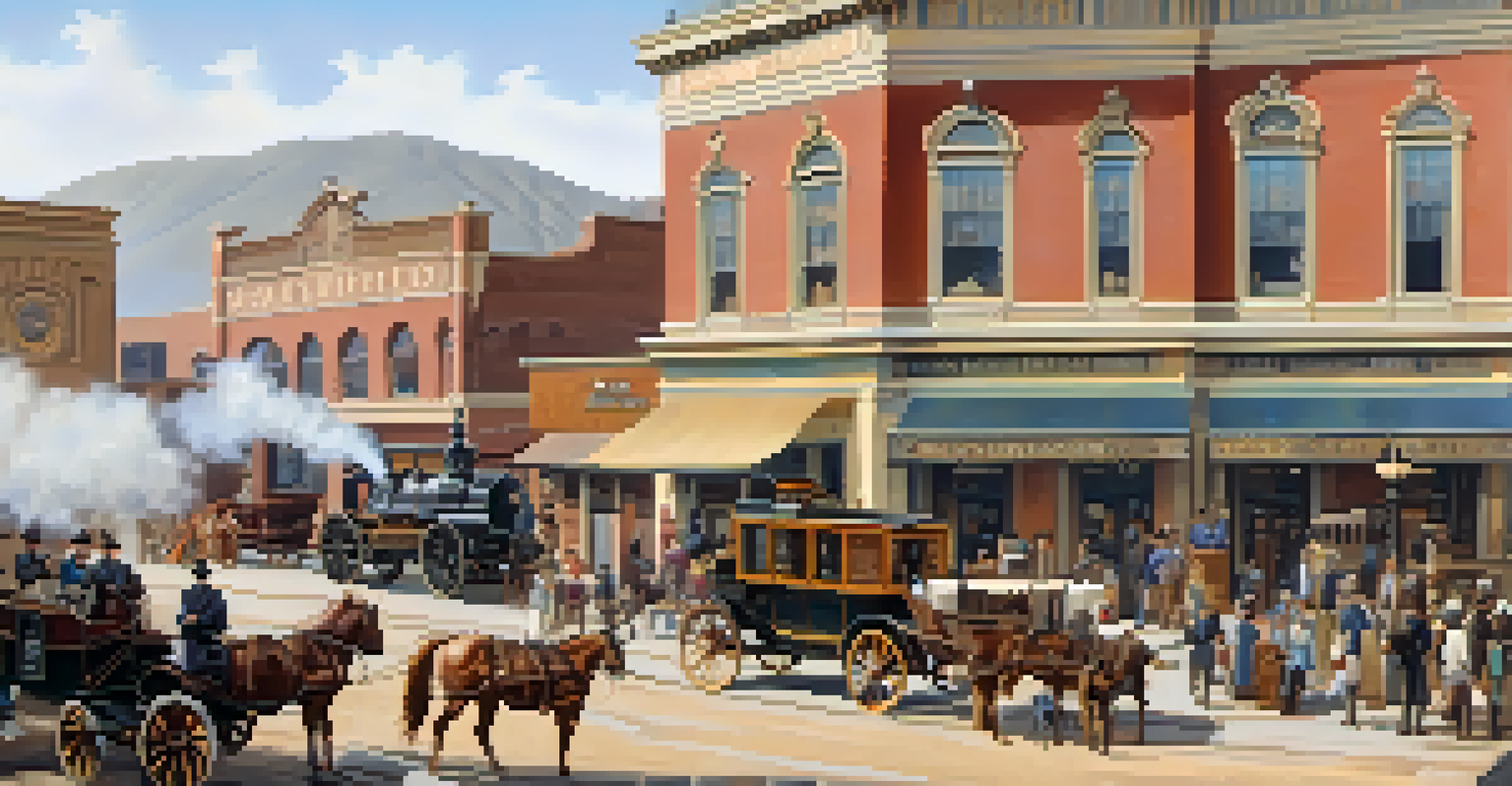The Southern Pacific Railroad: A Catalyst for Phoenix Growth

The Southern Pacific Railroad: An Overview
The Southern Pacific Railroad (SPR) was established in the 19th century, becoming a vital transportation network in the western United States. Stretching from San Francisco to New Orleans, it played a crucial role in connecting various regions, including the rapidly growing city of Phoenix, Arizona. The railroad not only facilitated the movement of goods and people but also spurred economic development in many areas it serviced.
The railroad is a great help to progress; it opens new horizons and connects people and places like never before.
Founded in 1865, the SPR initially focused on expanding its reach across California. However, as the demand for transportation increased, the railroad extended its lines into Arizona. This expansion was not just about tracks; it represented a lifeline for communities, allowing them to thrive and connect with broader markets.
As the railroad grew, so did its influence over local economies. Towns along the route saw a boom in population and commerce, and Phoenix was no exception. The Southern Pacific Railroad became a key player in transforming the area from a small desert settlement into a bustling city.
Economic Growth Driven by Rail Expansion
When the Southern Pacific Railroad reached Phoenix in 1887, it marked a turning point for the city’s economy. The influx of goods, resources, and people helped to stimulate local businesses and attract new industries. For instance, agricultural products from the surrounding areas could now reach distant markets more efficiently, boosting the agrarian economy.

The presence of the railroad also encouraged investment in infrastructure, leading to better roads, schools, and public services. This investment made Phoenix more attractive to potential residents and businesses alike. As more people moved to the area, the demand for housing and services surged, creating a positive feedback loop of growth.
Southern Pacific Railroad's Impact
The Southern Pacific Railroad was crucial in transforming Phoenix from a small settlement into a thriving urban center by enhancing transportation and economic opportunities.
Moreover, the railroad facilitated tourism, drawing visitors eager to explore the natural beauty of Arizona. The growth in tourism further diversified the local economy, leading to the establishment of hotels, restaurants, and entertainment venues. Thus, the Southern Pacific Railroad was a catalyst not only for economic growth but also for cultural development in Phoenix.
Population Boom and Urban Development
The arrival of the Southern Pacific Railroad played a significant role in the population boom of Phoenix. As more people flocked to the area for job opportunities and a better quality of life, the city's population swelled rapidly. This influx of newcomers brought diverse cultures and ideas, enriching the community fabric.
Transportation is the backbone of any economy; when goods move freely, communities thrive.
With the growing population, urban development followed suit. New residential neighborhoods sprang up, and commercial districts expanded to accommodate the needs of the burgeoning population. The demand for services, schools, and recreational areas increased, prompting local government to invest in infrastructure improvements.
This urban growth was not without its challenges, such as housing shortages and overcrowded public services. However, the Southern Pacific Railroad's commitment to the area ensured that Phoenix had the resources needed to evolve into a thriving urban center. The city’s transformation was a testament to the railroad's profound impact on its development.
The Role of the Railroad in Trade and Commerce
The Southern Pacific Railroad revolutionized trade and commerce in Phoenix by providing reliable transportation for goods. Local producers could ship their products to markets across the country, leading to increased sales and profits. This access to broader markets not only benefited local farmers but also attracted businesses looking to capitalize on the growing economy.
The availability of the railroad also encouraged the establishment of warehouses and distribution centers in Phoenix. These facilities enabled businesses to efficiently manage their inventory and streamline operations. As a result, Phoenix became a key hub for trade in the southwestern United States.
Boosting Trade and Commerce
By providing reliable transportation, the railroad revolutionized trade in Phoenix, allowing local producers to reach broader markets and attracting new businesses.
In addition to benefiting local businesses, the railroad's trade routes made Phoenix an attractive location for new enterprises. Entrepreneurs were drawn to the area, leading to a diverse economic landscape that included agriculture, manufacturing, and retail. The Southern Pacific Railroad’s influence on trade was a critical factor in shaping the city’s economic identity.
Cultural Impact of the Southern Pacific Railroad
Beyond its economic contributions, the Southern Pacific Railroad also left a lasting cultural legacy in Phoenix. The influx of new residents brought different customs, traditions, and perspectives, enriching the city's cultural scene. This melting pot of cultures fostered creativity and innovation that continues to define Phoenix today.
The railroad made travel easier and more accessible, allowing residents to explore other parts of the country. This exposure to diverse cultures and lifestyles contributed to a more cosmopolitan atmosphere in Phoenix. Local festivals, art exhibits, and culinary experiences began to reflect this rich tapestry of influences.
Moreover, the Southern Pacific Railroad helped establish connections with other cities and regions, fostering a sense of community and shared identity. As Phoenix grew, its residents began to take pride in their unique cultural heritage, further solidifying the city’s place in the broader American landscape.
Challenges and Adaptations of the Railroad
Despite its significant contributions, the Southern Pacific Railroad faced numerous challenges over the years. Competition from other transportation modes, such as trucks and airplanes, began to threaten its dominance in freight movement. This shift required the railroad to adapt its strategies to maintain its relevance in a changing marketplace.
Additionally, economic fluctuations and changes in demand forced the Southern Pacific Railroad to reassess its operations. At times, the company had to make difficult decisions regarding service routes and workforce management. However, its resilience and ability to innovate helped it navigate these challenges and continue serving the Phoenix area.
Cultural Enrichment Through Diversity
The arrival of diverse populations via the railroad enriched Phoenix's cultural landscape, fostering creativity and a sense of community.
The railroad's adaptability not only ensured its survival but also contributed to the ongoing growth of Phoenix. By adjusting to market demands and investing in new technologies, the Southern Pacific Railroad remained a vital component of the city’s infrastructure, enabling it to thrive despite external pressures.
The Legacy of the Southern Pacific Railroad in Phoenix
Today, the legacy of the Southern Pacific Railroad can still be felt throughout Phoenix. Its influence on the city's growth and development is evident in the bustling economy, diverse culture, and robust infrastructure. The railroad's initial investment in the region laid the groundwork for what Phoenix has become—a vibrant urban center.
Many of the neighborhoods and commercial areas established during the railroad's heyday continue to thrive today. The tracks that once carried freight and passengers have transformed into multi-use paths and rail trails, preserving the history of the Southern Pacific Railroad. These paths serve as a reminder of the city’s journey and its connection to the past.

As Phoenix continues to grow and evolve, the Southern Pacific Railroad's impact will remain a significant chapter in the city's story. The lessons learned from its history can inspire future developments, fostering a city that honors its heritage while embracing new opportunities for growth and innovation.